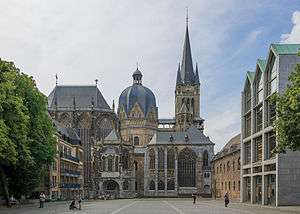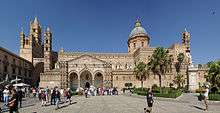Imperial Cathedrals
Imperial Cathedral (German: Kaiserdom) is the designation for a cathedral linked to the Holy Roman Emperors (Kaiser).
Rhenish Cathedrals
The three Romanesque cathedrals of Mainz, Worms and Speyer on the Upper Rhine are called Rhenish Imperial Cathedrals.
The construction of Mainz Cathedral was begun about 975 under Archbishop Willigis, then regent of the Holy Roman Empire for minor King Otto III. His seat was already meant as a kind of "state church", it was the first building of this size north of the Alps. The cathedral was completed in 1009, burnt down at the dedication, and was immediately rebuilt. Willigis may have planned to replace Aachen Cathedral as coronation church of the King of the Romans; indeed Otto's III successors Henry II (in 1002) and Conrad II (in 1024) were crowned in Mainz, but both presumably in the preceding building, since the present cathedral was not consecrated until in 1038. King Henry IV also contributed to the building after another blaze in 1081. Mainz Cathedral was the coronation site for Philip of Swabia, for Frederick II, and anti-king Henry Raspe.
Speyer Cathedral is the world's largest preserved Romanesque church (after the demolition of Cluny Abbey) and today a UNESCO World Heritage Site. It was built starting about 1025 by King Conrad II as a family vault for the ruling Salian dynasty. His successor Henry III donated the Speyer Gospels in 1046; the building was completed in 1061 under the rule of King Henry IV. During the Investiture Controversy with Pope Gregory VIII, he had the church again extended from 1081, in order to stress his Imperial authority. His mortal remains were transferred to the cathedral by his son Henry V in 1111.
Worms Cathedral, a highrising building, was built from about 1130 to 1181. It houses the tombs of Emperor Conrad's II family and also got its status because of its size and glory. The church was the site of the nomination of Pope Leo IX in 1048 and of the conclusion of the 1122 Concordat of Worms ending the Investiture Controversy. In 1235 the marriage of Emperor Frederick II with Isabella of England took place here.
Other
Less well known is that the basilica in the small town of Königslutter, built from 1135 as a family vault of the Supplinburger dynasty under the reign of Emperor Lothair II, also is traditionally called an Imperial Cathedral. The church was completed about 1070, more than 30 years after Lothair's death, by the Saxon duke Henry the Lion.
Bamberg Cathedral with its four towers also has the same status. Built from 1004 at the behest of the last Ottonian King Henry II and his wife Cunigunde of Luxembourg, it is the site where the only canonized imperial couple has their grave. In 1046 Bishop Suidger of Bamberg was elected Pope Clement II; his grave at the cathedral is the only tomb of a Pope north of the Alps. The church building is part of the historic Town of Bamberg, today listed as a World Heritage Site.
Aachen Cathedral, another World Heritage Site, and Frankfurt Cathedral (St Bartholomew Church) were also described as Imperial cathedrals because they were the election and coronation cathedrals of the German monarchs.
Palermo Cathedral houses the mausoleum of the Hohenstaufen emperors.
Gallery




 Königslutter Cathedral
Königslutter Cathedral